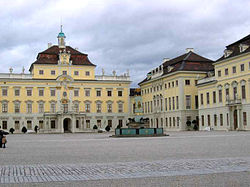Ludwigsburg
| Ludwigsburg | ||
|---|---|---|

Ludwigsburg Palace, inner courtyard
|
||
|
||
| Coordinates: 48°53′51″N 9°11′32″E / 48.89750°N 9.19222°ECoordinates: 48°53′51″N 9°11′32″E / 48.89750°N 9.19222°E | ||
| Country | Germany | |
| State | Baden-Württemberg | |
| Admin. region | Stuttgart | |
| District | Ludwigsburg | |
| Government | ||
| • Mayor | Werner Spec | |
| Area | ||
| • Total | 43.33 km2 (16.73 sq mi) | |
| Elevation | 293 m (961 ft) | |
| Population (2015-12-31) | ||
| • Total | 92,973 | |
| • Density | 2,100/km2 (5,600/sq mi) | |
| Time zone | CET/CEST (UTC+1/+2) | |
| Postal codes | 71634–71642 | |
| Dialling codes | 07141 | |
| Vehicle registration | LB | |
| Website | www.ludwigsburg.de | |
Ludwigsburg (German pronunciation: [ˈlʊtvɪçsˌbʊrk]) is a city in Baden-Württemberg, Germany, about 12 kilometres (7.5 mi) north of Stuttgart city centre, near the river Neckar. It is the largest and primary city of the Ludwigsburg district with about 88,000 inhabitants. It is situated within the Stuttgart Region, and the district is part of the administrative region (Regierungsbezirk) of Stuttgart.
The area around Ludwigsburg had been a favored hunting grounds by the royal Württemberg family for generations before the founding of Ludwigsburg. Although the region was wilderness, it was easily accessible by boat using the Neckar River. In 1704 the founder of Ludwigsburg, Eberhard Louis, Duke of Württemberg, arranged for the laying of the foundation stone for Ludwigsburg Palace. Ludwigsburg is named after the Duke Eberhard Louis' middle name, Ludwig being the German name for Louis. Right up until his death, construction workers and craftsmen worked on what was to become one of the largest Baroque palace ensembles in Europe. Under Eberhard Louis and his successor, Charles Eugene, the Palace served as the royal residence of Württemberg for a total of 28 years. With the Palace as their gesamtkunstwerk (translated literally, "collective work of art") and the opulent festivals they organized, the Dukes put their unbounded power on display with no consideration for the finances of Württemberg. To them, their most important task was to bring fame and renown to the court of Württemberg and to compete with and outdo other European rulers in this regard.
Duke Eberhard Louis planned to found an ideal Baroque city right beside Ludwigsburg Palace. From 1709 onwards, he tried to attract new residents to the city with a series of incentives: first he promised free plots of land and free building materials as well as fifteen years tax-free status, and later on he added freedom to practice one's profession and religion to the list. However, the town only began to grow when it was granted city status in 1718 and then in that year became the royal residence and capital city of the country of Württemberg. By the time of Eberhard Louis' death in 1733, the population had risen to around 6,000 people, which was more than half as big as the former capital city Stuttgart. Nevertheless, the new capital city Ludwigsburg was still a major construction site with many unpaved streets and half-finished buildings.
...
Wikipedia


